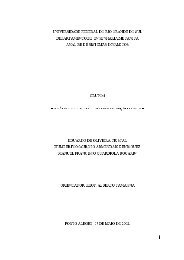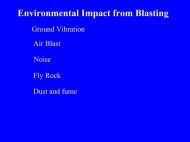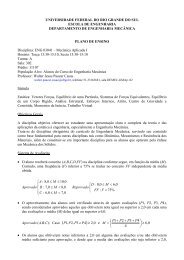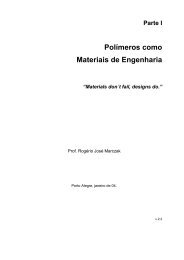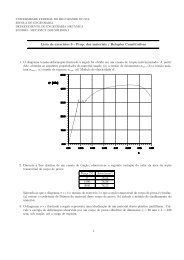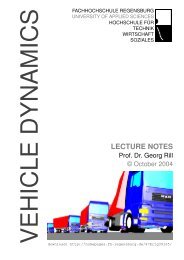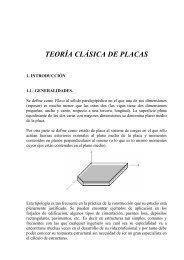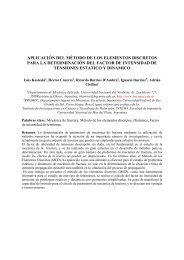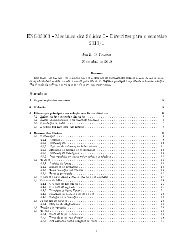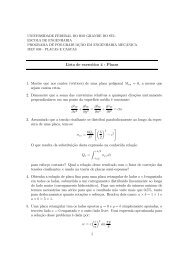Uniaxial True Stress-Strain after Necking
Uniaxial True Stress-Strain after Necking
Uniaxial True Stress-Strain after Necking
Create successful ePaper yourself
Turn your PDF publications into a flip-book with our unique Google optimized e-Paper software.
necking or flow instability must be considered. The first ofthem is diffuse necking, so called because its extent is muchgreater than the sample thickness. It is illustrated in Figure 2.This form of instability is analogous to necking of rods. Diffusenecking starts when the tensile load reaches its maximum. Itmay terminate in fracture but is often followed by a secondinstability process called localized necking of thin strips. In thismode the neck is a narrow band inclined at an angle to thespecimen axis, as shown in Figure 2. Once localized neckingstarted, the width of the sample contracts little, but the thicknessalong the necking band shrinks rapidly. Fracture occurssoon <strong>after</strong>.Figure 2. Illustration of the difference between localized anddiffused neck during necking of a thin strip.Bridgman’s correction method for flat samples does not considerlocalized necking. Therefore, it is not surprising that themethod apparently has not been applied successfully. The reasonfor the failure is that all three assumptions were found to beincorrect for flat strips:x The strain distribution at the minimum cross-section becomeshighly non-uniform when localized necking begins.The average axial strain(e x ) av 5 ln 1 A 0A 2 , (23)can be considerably smaller than the maximum axial strainat the minimum cross section. 6 Thus, even if the instantaneousdimension of the minimum section is known, theequivalent strain is still not defined. More complicatedtechniques such as the grid method have to be used tomeasure strain across the minimum cross section.x To obtain the equivalent uniaxial stress, one has to solvefor the distribution of stresses s x and s y across the minimumsection. To do this analytically, one needs to find thecurvatures of the longitudinal grid lines during necking.Aronofsky’s experimental work 6 suggests that Bridgman’scurvature assumption does not apply to flat samples. Onewould have to measure the curvature not only for the outerprofile but also for many other longitudinal grid linesacross the minimum section. This would make the testingdifficult and time consuming.x The ratios of the principal stresses do not remain constantduring loading and the incremental theory of plasticity mayhave to be used, which makes the analytical solution forthe stress distribution at the minimum section very difficult,if not impossible.Although theoretically development of a correction method forobtaining the true stress/train relation <strong>after</strong> necking for flatsamples is still possible, it would be very difficult and costly toapply it.WEIGHTED AVERAGE METHODCorrection methods were developed before the powerful FEMswere available. FEM was shown to permit simulation of thenecking phenomenon very well. There have been numerousstudies on this subject. 9 Most of them focused on the problemof how necking develops for a given stress-strain relation. Theopposite, practically more important problem, of finding for agiven load-extension curve the corresponding true stress-strainfunction attracted little attention.The only such work the present author is aware of is by Zhangand Li. 8 There, the experimental tensile load-extension curve isconsidered as target and the true stress-true strain relation issearched for iteratively by finite element analysis (FEA) untilthe target is reached within a certain tolerance. The methodworked well for a round sample of a middle-carbon steel: theobtained true stress-strain relation was in good agreement withthat determined by Bridgman’s correction method. ThoughZhang and Li studied only round samples, the concept appliesalso to flat samples. The main advantage of their method is thatthe true stress-true strain data can be extracted from results ofstandard tensile tests which does not have to be interrupted atdifferent loads to determine profiles and dimensions at theneck, as required by the correction method. The main shortcomingis that the entire stress-strain relation beyond necking istreated as unknown and iterations are required for a series ofstrain intervals making the computation extremely extensiveand time-consuming. Another drawback is that the methodrequires a specially written FEA program to do the numericalsearching. For most engineers, developing a robust FEA programfor nonlinear plastic analysis is not a trivial task.Therefore, availability of a method similar in principle toZhang and Li’s approach but much simpler is highly desirable.A power law is often used to represent the whole flow curve 10 ,for instances5Ke n , (24)where K and n are empirical constants determined from knowntrue stress-strain data before necking. Modern FEA programsdo not require input of the uniaxial true stress-strain function inanalytical form. It is entered numerically as ordered pairs takenfrom experimental data and the power law or any other functionin analytical form are not necessary for curve fitting themeasured true stress-strain data before necking. The power lawmay be useful for extrapolation of the true stress-strain curvebeyond necking.Let e u be the true strain at which necking starts and s u theAMP Journal of Technology Vol. 5 June, 1996 Y. Ling 41
corresponding true stress. They can be calculated from theultimate tensile strength s u and the corresponding uniformengineering strain e u :At the onset of necking it isande u 5 ln (1 1 e u ),s u 5 s u (1 1 e u ). (25)s0 e5eu 5s u ,dsde 0 e5e u5s u . (26)Note that the second equation in (26) is the well known conditionfor initial necking. If the power law is used to extrapolatethe true stress-strain relation beyond necking, the onset ofnecking should be reserved, i.e., the constants K and n aredetermined by equations (26) asandK 5 s ue ue un 5e uand the extrapolation equation becomess51 s uee u u2 eeu . (27)In a log-log plot the power-law is represented by a straight line.However, from observation it is known that in a log-log diagramof the true stress vs. true strain curve the slope tends toincrease slightly beyond necking. This behavior is illustrated inFigure 3 for a phosphor bronze alloy. It was observed for allcopper alloys examined, which included phosphor bronze,brass, pure copper, and beryllium copper. Thus, the power-lawextrapolation appears to underestimate true stresses and it isreasonable to assume that for copper alloys the power lawextrapolation gives a lower bound for the true stress.For many copper alloys, a straight line was found to representthe true stress-strain relation better than the power law. Thus,one may also assume a linear relationship between the truestress and true strain <strong>after</strong> neckings5a 0 1a 1 e, (28)where a 0 and a 1 are two constants, determined from equations(26) as a 0 5s u (1-e u ) and a 1 5s u , which yieldss5s u (1 1e2e u ). (29)Figure 3. <strong>True</strong> stress-strain plot. The log-log presentationshows that the power law extrapolation tends to underestimatethe true stress.—Sample: C511-Hard-Longitudinal. Foradditional data see Table 1.The linear extrapolation suggests that <strong>after</strong> necking the slopeds/de of the true stress-true strain curve remains constant, orthe strain hardening rate does not change as the strain becomeslarge. Observation shows that this is usually not the case: strainhardening rate generally decreases with increasing true strain.Therefore, the linear extrapolation will generally lead to overestimatetrue stresses and give an upper bound.Since the lower and upper bounds for true stresses <strong>after</strong> neckinghave been identified, a better approximation of the truestress is to use the weighted average of the lower and upperbounds defined by equations (27) and (29), respectively:s5s u3 w(1 1e2e u)1(1 2 w)1 eeue ue u24, (30)where w, with 0 # w # 1 is an unknown weight constant. Theupper boundary of this closed interval, i.e., w 5 1 representsthe linear extrapolation, the lower bound, w 5 0, the powerlaw. The central point, w 5 1/2, is the average of both.To determine the weight constant w Zhang and Li’s approach 8is followed. The measured tensile load-extension relation, F(e),i.e., the engineering curve is considered the target and theweight constant w is varied in a finite element model until thecalculated load-extension relation F * (e,w) agrees with F(e)within pre-defined limits. This optimization problem can beformulated asmin (d), (31)0#w#1where d is an error measuring the difference between F * (e,w)42Y. Ling AMP Journal of Technology Vol. 5 June, 1996
and F(e), for instanced5e eue f[F*(e, w) 2 F(e)] 2 de (32)with e f 5 relative elongation, or engineering strain, immediatelyprior to fracture. Note that the error is evaluated from theonset of necking to fracture, since the true stress-strain relationbefore necking has been well defined and the load-extensionrelation can be measured precisely before necking.The weighted average method presented in this paper uses onlyone variable w, while in Zhang and Li’s method the searchinghas to be done for a series of stresses and strains. It is thus a farsimpler method. Moreover, it was found experimentally that thelargest error always occurs immediately before fracture, i.e., ate 5 e f . When F * (e f ,w) < F(e f ), the calculated load-extensioncurve matches the experimental one very well. Thus, instead ofperforming the rigorous optimization process, one may simplydetermine w such thatF*(e f ,w)2 1 < 0. (33)F(e f )Usually a satisfactory value of w can be obtained by a fewtrials. Examples are given below.RESULTSThe finite element program ABAQUS 11 was used to simulatethe tensile test. One fourth of the sample was modeled, asshown in Figure 4, using the eight-node-plane-stress elementwith reduced integration (CPS8R). <strong>Necking</strong> is induced by theend condition and generally no imperfection in width is neededto initiate it. Fine meshing is located near the center of thesample where the strain gradient is expected to be large. Modelswith meshes of 20 by 8 and 25 by 10 within the gaugelength are analyzed to check numerical convergence. The loadextensioncurves obtained for the two different meshes werefound to be almost identical. Thus, the mesh of 20 by 8 wasconsidered adequate.The materials of the examples are listed in Table 1. They includevarious copper alloys of various tempers ranging fromvery soft pure copper (C10200-1/8Hd) to high temper phosphorbronze (C52100-10M). For phosphor bronze C51100, a weightingconstant w 5 0.50 was tried first. The corresponding loadextension,i.e., the engineering stress-strain curve is shown inFigure 4. Finite element mesh.Figure 5a. The calculated curve is slightly below the measuredone, indicating that using w 5 0.50 slightly underestimatesactual strain hardening. Thus, a slightly larger value w 5 0.55was tried with the result that calculated and experimental loadextensioncurves agreed well. Further refinement led to a valueof w 5 0.54, which yielded almost perfect agreement. Theresulting true stress-strain relation is shown in Figure 5b. Forother materials listed in Table 1 experimental load-extensioncurves and the resulting true stress-strain relations are shown inFigures 6 to 9.All examples show that the target load-extension curve can bereproduced by simulation with great accuracy provided the truestress-strain relation <strong>after</strong> necking is adjusted by choosing aproper weight constant w. The question if the true stress-strainrelation found by this method is the correct one in an absolutesense remains open. A rigorous proof would have to considerthe issue of the uniqueness of the solution. Instead of attemptingsuch proof an engineering argument is offered here. Whentrue stresses are underestimated, a material possesses less strainhardening than it should have. This insufficient strain hardeningis directly reflected in the calculated load-extension curve,which would fall below the experimentally determined targetcurve. Consequently, it will predict that necking develops toofast or too early <strong>after</strong> its initiation. On the other hand, if truestresses are overestimated, the material will have excessivestrain hardening, and the calculated load-extension curve willbe above the target curve, which means that necking woulddevelop too slowly or too late. Therefore, a true stress-strainrelation that reproduces the experimentally determined loadextensioncurve should correctly represent the strain hardeningfunction of a material.To further verify the weighted-average method, a rod of a mildcarbon steel is considered. Tensile test data for this materialhave been reported by Zhang and Li. 8 They also measured thenominal stress and applied Bridgman’s correction method toobtain the uniaxial true stress-strain function up to fracture. TheTable 1. Mechanical properties of alloys studied. L 5 longitudinal, T 5 transverse.Alloy Temper Orientation Modulus E, Mpsi Tensile Strength s u , kpsi Uniform <strong>Strain</strong> e u , % Elongation e f , % Sample Thickness t, milsC51100 Hd L 16.5 80.6 7.60 11.0 15.5C52100 10M L 15.6 120.7 1.87 7.20 13.9C26000 Extra Hd L 15.5 84.4 4.38 9.60 12.6C10200 1/8 Hd T 16 35 30.5 42.0 45.5C17510 TM04 T 18 124.1 11.0 14.4 8AMP Journal of Technology Vol. 5 June, 1996 Y. Ling 43
Figure 5. Comparison of load vs. engineering strain with truestress vs. strain for alloy C51100. (a) Load vs. engineeringstrain curves. (b) <strong>True</strong> stress vs. true plastic strain curve.—Sample: C511-Hard-Longitudinal.Figure 6. Comparison of load vs. engineering strain with truestress vs. strain for alloy C521. (a) Load vs. engineeringstrain curves; applied weight constants, w, used for FEA aregiven in the insert. (b) <strong>True</strong> stress vs. true plastic straincurve.—Sample: C521-10 M-Longitudinal.purpose here is to check whether the true stress-strain relationdetermined by the weighted-average method agrees with thatobtained by Bridgman’s correction method. By simulating thetensile test of the rod with different weight constants w, it wasfound that with a weight constant of about 0.45 the calculatedload-extension curve agrees well with the experimental one.The results are shown in Figure 10. In Figure 11 are comparedthe true stress-strain relation <strong>after</strong> necking calculated by equation(30) with w 5 0.45, the true stress-strain data determinedby Bridgman’s correction method and those found by theZhang and Li procedure. The results from the three methods arequite close. It is concluded that the weighted-average methodpredicts the true stress-strain relation <strong>after</strong> necking as well asthe two other methods. The results also show that all calculatedweight constants are in the range 0 # w # 1. This verifies thelower and upper bound assumption at least for the materialsstudied.Not yet addressed was the question of how to predict the end ofthe true stress-strain curve, i.e. the prediction of the fracturestrain. To solve this problem one needs to follow the strain44Y. Ling AMP Journal of Technology Vol. 5 June, 1996
Figure 7. Comparison of load vs. engineering strain with truestress vs. strain for alloy C26000. (a) Load vs. engineeringstrain curves; applied weight constants, w, used for FEA aregiven in the insert. (b) <strong>True</strong> stress vs. true plastic straincurve.—Sample: C260-Extra Hd-Longitudinal.Figure 8. Comparison of load vs. engineering strain with truestress vs. strain for alloy C10200. (a) Load vs. engineeringstrain curves; applied weight constants, w, used for FEA aregiven in the insert. (b) <strong>True</strong> stress vs. true plastic straincurve.—Sample: C102-1/8 Hd-Transverse.evolution during tensile loading. It is known that fracture in atensile sample occurs first at the center of the sample becausethe maximum strain occurs there. For phosphor bronze C51100it is shown in Figure 12 the maximum strain evolution withincreasing engineering strain. The strain in the axial direction isreferred to as the major strain, that in the width direction as theminor strain. The equivalent strain is almost the same as themajor strain. Since the elongation e f is the maximum engineeringstrain the sample can withstand without failure, theequivalent strain corresponding to the elongation should be thefracture strain e f . It can be found from Figure 12 to be e f
Figure 10. Comparison of calculated and measured load vs.extension curves. Measured data according to Zhang and Li 8 .even through conventional or standardized measurement techniques.At best a conservative estimate of the fracture strain canbe given. One way to do this is to measure the cross sectionalarea A f at fracture and use the average axial strain in the small-Figure 9. Comparison of load vs. engineering strain with truestress vs. strain for alloy C17510. (a) Load vs. engineeringstrain curves; applied weight constant, w, used for FEA isgiven in the insert. (b) <strong>True</strong> stress vs. true plastic straincurve.—Sample: C17510-TM04-Transverse.Figure 12 where it is shown that the maximum strain increasesvery steeply near fracture. Calculations involving such largeslopes are usually not reliable. A slight variation in elongationor even a small numerical disturbance can cause significantdifferences in the calculated fracture strain. The large slope ofexperimental load-deflection curves near fracture also makesaccurate measurements of fracture strain very difficult. In fact,fracture strains determined in formability testing generally havea great deal of scattering. 12 Thus, it is unlikely that one canaccurately determine the fracture strain through calculation orFigure 11. Comparison of true stress vs. strain relationshipsobtained by different methods. Measured data according toZhang and Li 8 .46Y. Ling AMP Journal of Technology Vol. 5 June, 1996
method. Bridgman’s correction method is shown to be inappropriatefor determining true stress-strain functions for stripsamples <strong>after</strong> necking.The power law extrapolation of the true stress-strain relationbeyond necking is found, at least for the materials listed inTable 1, to be the lower bound for the true stress-strain relation,a linear extrapolation with properly determined constantsserves as the upper bound. Using a weight constant, w, theactual true stress-strain function <strong>after</strong> the onset of necking canbe well represented by the weighted average of the two boundss5s u3 w(1 1e2e u)1(1 2 w)1 eeuwith 0 # w # 1.e ue u24, (35)This expression is suitable for reproducing experimental tensileload-extension curves in FEA with great accuracy by properselection of the weight constant w.Figure 12. Illustration of changes of maximum true strainwith increasing values of engineering strain.—Sample: C511-Hard-Longitudinal.est sectione f 5 ln 1 A 0A f2 (34)as the fracture strain. This method will yield a conservativeestimate because the maximum strain at this section can beconsiderably larger. Estimation of e f using this approach isessentially the same as that for rods and has been applied frequently.13CONCLUSIONA new method for predicting true stress-strain functions fromengineering stress-strain data was developed and shown to offeradvantages over methods commonly known. The new methodutilizes weighted averages of upper and lower bound of stressstraincurves and is consequently called the weighted averageTable 2. Calculated strains values at fracture.Alloy Temper OrientationWeightconstant wMajor<strong>Strain</strong>,%Minor<strong>Strain</strong>,%Equivalent<strong>Strain</strong>, %C51100 Hd L 0.54 98 228 98C52100 10M L 0.68 92 226 94C26000 Extra Hd L 0.69 70 226 72C10200 1/8 Hd T 1.00 216 250 220C17510 TM04 T 0.40 76 228 76The weighted average method is not recommended for predictionof fracture strain. Instead, the conventional methodinvolving measuring the minimum cross-sectional area atfracture may be used.REFERENCES1. S. Kugener, ‘‘Simulation of the Crimping Process by Implicitand Explicit Finite Element Methods,’’AMP J. ofTechnol., 4, 8-15 (1995).2. ASTM E 8M—86a, ‘‘Tensile Testing of Metallic Materials,’’Annual Book of ASTM Standards, 03.01 (ASTM,Philadelphia, PA, 1987).3. P.W. Bridgman, Studies in Large Plastic Flow and Fracture(McGraw-Hill, New York, 1952).4. G.E. Dieter, Mechanical Metallurgy (McGraw-Hill, NewYork, 1986).5. R. Hill, The Mathematical Theory of Plasticity (Clarendon,Oxford, 1950).6. J. Aronofsky, ‘‘Evaluation of <strong>Stress</strong> Distribution in theSymmetrical Neck of Flat Tensile Bars,’’ J. App. Mech.,March 1951, 75-84 (1951).7. N.N. Davidenkov and N.I. Spiridonova, ‘‘Analysis of theState of <strong>Stress</strong> in the Neck of a Tensile Test Specimen,’’Proc. ASTM, 46, 1147-1158 (1946).8. K.S. Zhang and Z.H. Li, ‘‘Numerical Analysis of the<strong>Stress</strong>-<strong>Strain</strong> Curve and Fracture Initiation for DuctileMaterial,’’ Engrng. Fracture Mech., 49, 235-241 (1994).9. V. Tvergaard, ‘‘<strong>Necking</strong> in Tensile Bars with RectangularCross-Section,’’ Comp. Meth. Appl. Mech. and Engrng.,103, 273-290 (1993).AMP Journal of Technology Vol. 5 June, 1996 Y. Ling 47
10. J.H. Hollomon, ‘‘Tensile Deformation,’’ Trans. AIME, 162,268 (1945).11. ABAQUS/STANDARD User’s Manuals, Version 5.4,(Hibbitt, Karlsson & Sorensen, Inc., Pawtuckett, RI, 1994)12. A.A. Tseng, ‘‘Material Characterization and Finite ElementSimulation for Forming Miniature Metal Parts,’’ FiniteElements in Analysis and Design, 6, 251-265 (1990).13. W.F. Hosford and R.M. Caddell, Metal Forming: Mechanicsand Metallurgy (PTR Prentice Hall, Englewood Cliffs,NJ, 1993).Yun Ling is a Senior Development Engineer in the GlobalTechnology Group of AMP Incorporated, Harrisburg, Pennsylvania.Dr. Ling received his Bachelor of Science and Master of Sciencedegrees in mechanical engineering from Nanjing Instituteof Technology, China, and earned a Ph.D. degree in mechanicalengineering from the State University of New York at Binghamton.He published more than 15 technical papers in thefields of rotor dynamics, hyperelasticity, materials characterization,and electronic packaging. His present interest is focussedon mechanical properties of materials and connector mechanics.48Y. Ling AMP Journal of Technology Vol. 5 June, 1996




